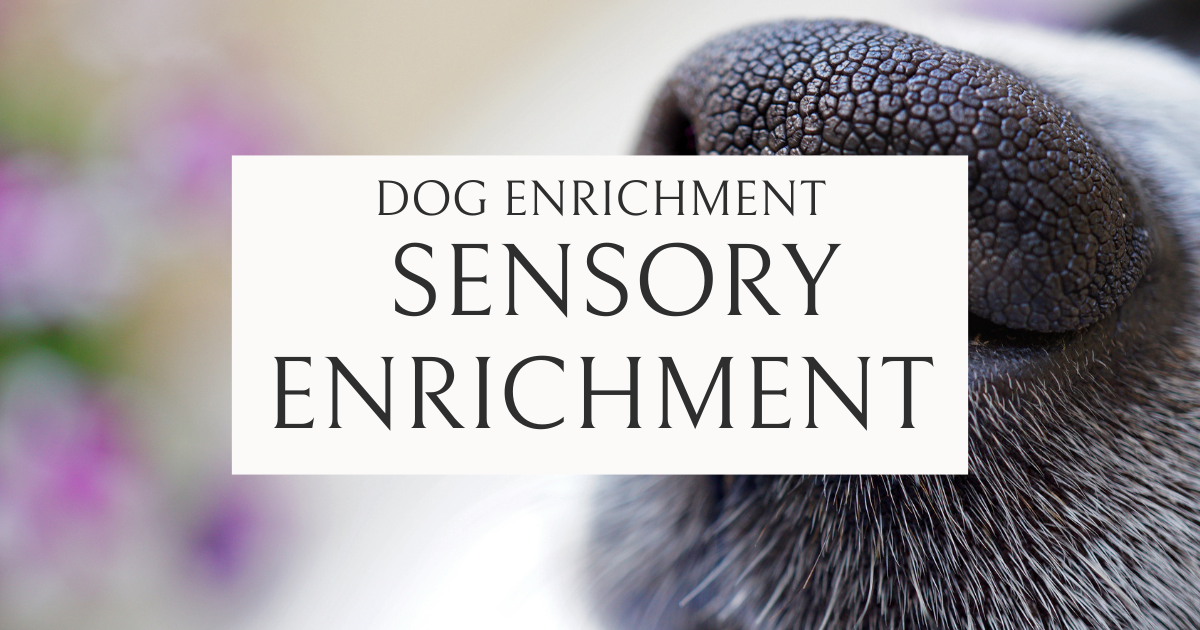Welcome to our informative Sensory Enrichment Q&A! In this post, we’ll tackle some of the most common questions and provide insightful answers about sensory enrichment for dogs. We understand that our furry friends experience the world through their senses, and by providing sensory stimulation, we can enhance their overall well-being and quality of life. For a Sensory Enrichment Deep Dive, check out this post: Exploring Sensory Enrichment for Your Dog: A Complete Guide
From engaging their sense of smell and sight to offering tactile and auditory experiences, sensory enrichment plays a vital role in keeping our dogs happy and fulfilled. So, let’s dive into the realm of sensory enrichment and explore the answers to your burning questions!
This Q&A will cover various topics related to sensory enrichment, such as the benefits of sensory stimulation, different sensory activities, creating sensory-rich environments, and more. Let’s dive in.
Q: What is sensory enrichment for dogs?
A: Sensory enrichment refers to activities and toys that stimulate a dog’s senses, including sight, sound, smell, taste, and touch.
Q: Why is sensory enrichment important for dogs?
A: Sensory enrichment provides mental and physical stimulation, which can help prevent boredom and improve a dog’s overall well-being.
Q: What are the benefits of sensory stimulation for dogs?
A: Sensory stimulation offers a range of benefits for dogs, both mentally and physically. It helps prevent boredom and provides mental engagement, which is essential for their overall well-being. Sensory activities can enhance cognitive function, improve problem-solving skills, and promote learning. Additionally, sensory stimulation satisfies a dog’s natural instincts and curiosity, reducing anxiety and stress levels. It also encourages physical exercise and can strengthen the bond between dogs and their humans.
Q: What are some examples of sensory activities for dogs?
A: There are numerous sensory activities you can incorporate into your dog’s routine.
Here are a few examples:
- Scent games: Engage your dog’s sense of smell by hiding treats or toys for them to find using their nose.
- Tactile experiences: Provide different textures for your dog to explore, such as a variety of surfaces to walk on or toys with different materials.
- Visual stimulation: Create a visual feast for your dog by using interactive toys with moving parts or watching nature videos together.
- Auditory enrichment: Play calming music, nature sounds, or even audiobooks specifically designed for dogs to provide auditory stimulation.
- Taste adventures: Offer your dog a variety of safe and appropriate treats with different flavors and textures.
Q: How can I create a sensory-rich environment for my dog?
A: Creating a sensory-rich environment is key to providing ongoing sensory stimulation for your dog.
Consider the following:
- Outdoor exploration: Take your dog on walks in different environments, allowing them to experience new smells, sights, and sounds.
- Sensory toys: Provide a variety of toys that engage different senses, such as puzzle toys, squeaky toys, or toys with different textures.
- Safe exposure: Introduce your dog to new experiences gradually and positively, whether it’s meeting new people, encountering different animals, or exploring new places.
- Nature adventures: Plan outings to parks, beaches, or hiking trails where your dog can immerse themselves in the natural world and engage all their senses.
- Playtime variety: Rotate and introduce new toys regularly to keep their interest levels high and provide ongoing sensory stimulation.
Remember, each dog is unique, so observe their preferences and adjust the sensory activities and environment accordingly. Always prioritize their safety and well-being while engaging their senses to create a fulfilling and enriching experience for your furry friend.
Q: What are some examples of sensory enrichment activities for dogs?
A: Examples include scent games, puzzle toys, music or sound therapy, flavored toys, and different textures of toys or surfaces.
Q: Can sensory enrichment help with behaviour issues?
A: Yes, sensory enrichment can help address behaviour issues such as anxiety and destructive chewing by providing a positive outlet for a dog’s energy and mental stimulation.
Q: What are some tips for incorporating sensory enrichment into a dog’s daily routine?
A: Varying toys and activities regularly, monitoring for any safety concerns, and providing ample opportunities for exploration and play are all important for effective sensory enrichment.
Related: Creating a Dog Enrichment Schedule
Q: Can all dogs benefit from sensory enrichment?
A: Yes, all dogs can benefit from sensory enrichment activities, but it’s important to take into account a dog’s individual needs and preferences when selecting activities and toys.
We hope this Sensory Enrichment Q&A has provided you with valuable insights into the world of dog enrichment and the importance of sensory stimulation. For more detailed information and practical ideas, be sure to visit our website and explore our related blog posts. We highly recommend you check out this post next: Exploring Sensory Enrichment for Your Dog: A Complete Guide
We’re dedicated to helping you provide the best sensory experiences for your furry friend, allowing them to explore the world through their senses and enrich their lives. Remember, by incorporating sensory enrichment into your dog’s routine, you’re providing them with an array of stimulating experiences that cater to their unique sensory preferences. So, let’s continue to delight our dogs with sensory adventures and watch them thrive in a rich and fulfilling sensory world!



